|
TAMPA'S MAY FESTIVALS and the ROOTS OF THE GASPARILLA PARADE &
CELEBRATION
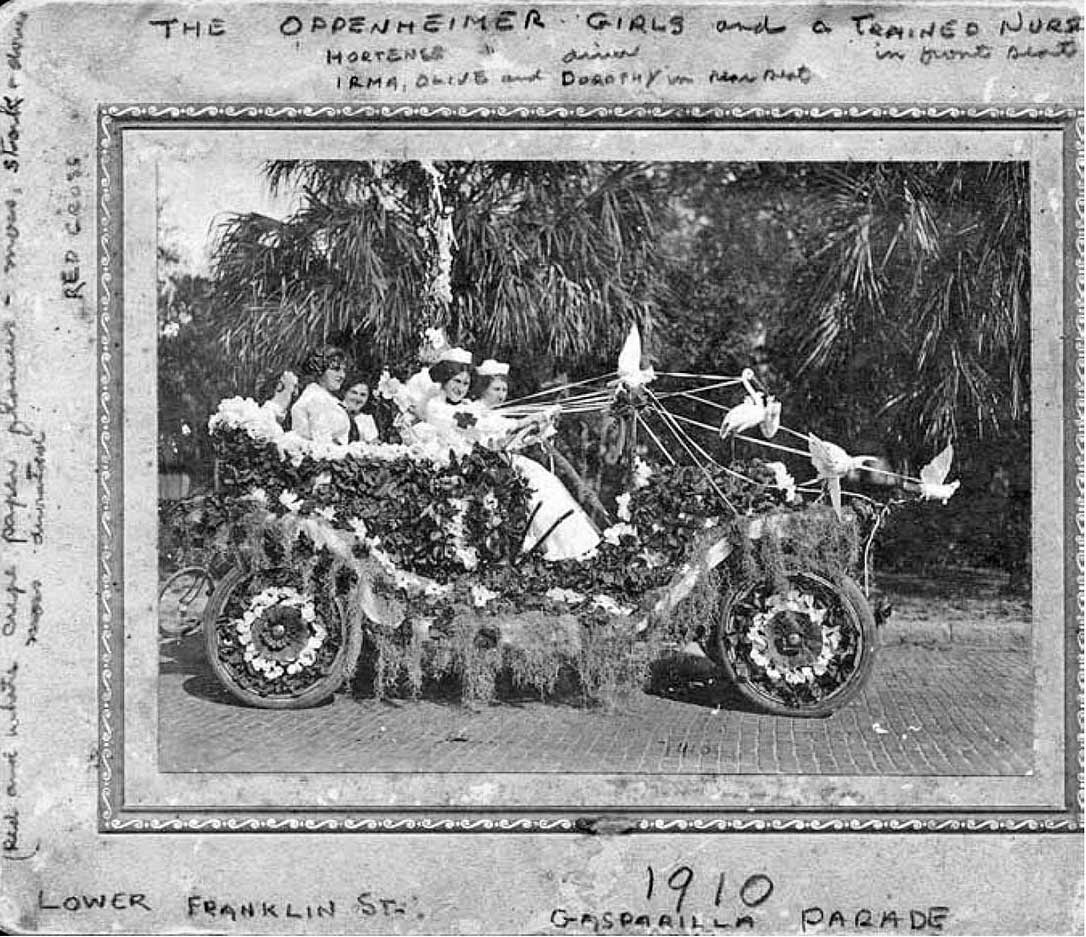
Contrary to what was written on the
photo years later, this was NOT from the 1910 "Gasparilla Parade."
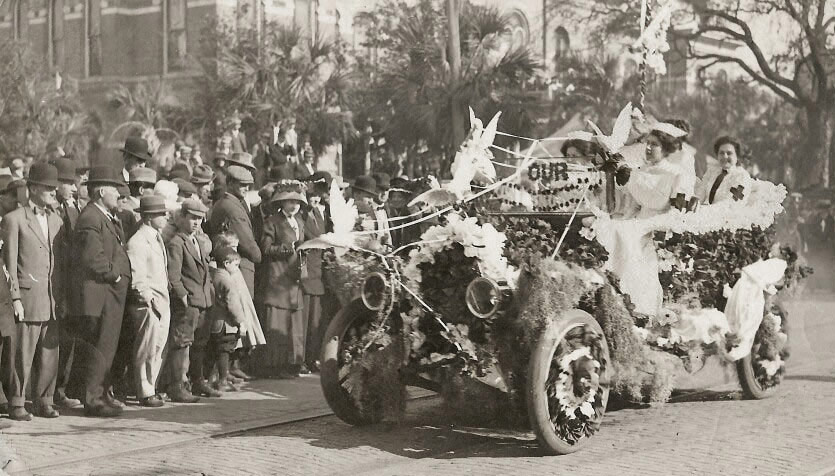
|
Photo from
WUSF.ORG where they provide a caption: The Gasparilla parade in
1910 was the last year the invasion was done on horseback.
The following year was the first "invasion by boat."
Original
photo provided by the Tampa Bay History Center. TampaPix Note: This photo wasn't from 1910. In 1910 Ye Mystic Krewe
pirates were part of Tampa's Panama Canal celebration.
These photos are from the
1911 Celebration of the 1910 Census results.
An event
celebrating the tremendous growth of Tampa's population, this
automobile used storks and "nurses" to represent Tampa's "population
explosion." |
|
|
|
There was
no "Gasparilla Parade" in the early years
because is was not called the "Gasparilla Parade" until
years later when it became its own event.
The appearance of the "GASPARILLAS" began as a part of Tampa's May Festival
Floral Parade of carriages in 1904.
The May Festival was first held in 1903 but in 1904, Louise Frances Dodge claimed it wasn't what it could have been due to short planning time. |
|
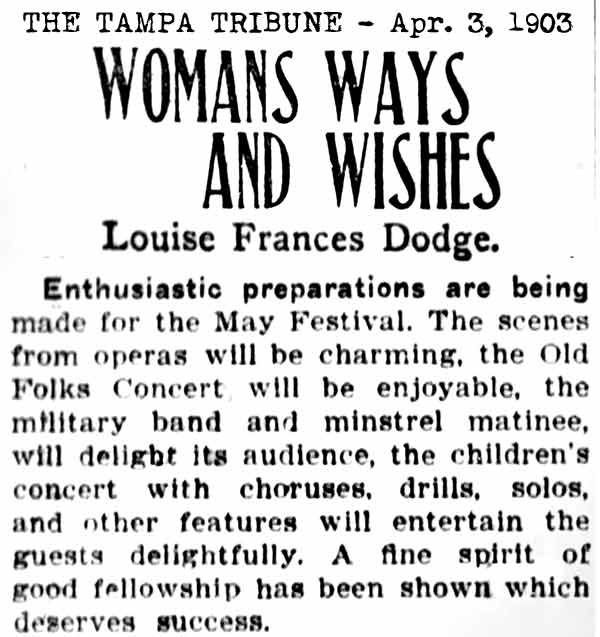
TAMPA'S
1903 MAY FESTIVAL
"Enthusiastic preparations" for the 1903 festival began
in early April. Among events were to be scenes
from operas, an Old Folks concert, a military band, a
minstrel matinee, and a children's concert with
choruses, drills, and solos. In mid-April more
details were announced: the opera scenes were to
be performed by "some of the prominent singers of the
city." The children's concert performed by the high
school, Convent, St. Petersburg schools and others.
Misc. concerts by musicians of the city and of St. Pete,
the old folks concert in costume, and the military band
by the "Sons of Ham." (Likely a reference to one of
Noah's three sons who was the father of Canaan.) |
| |
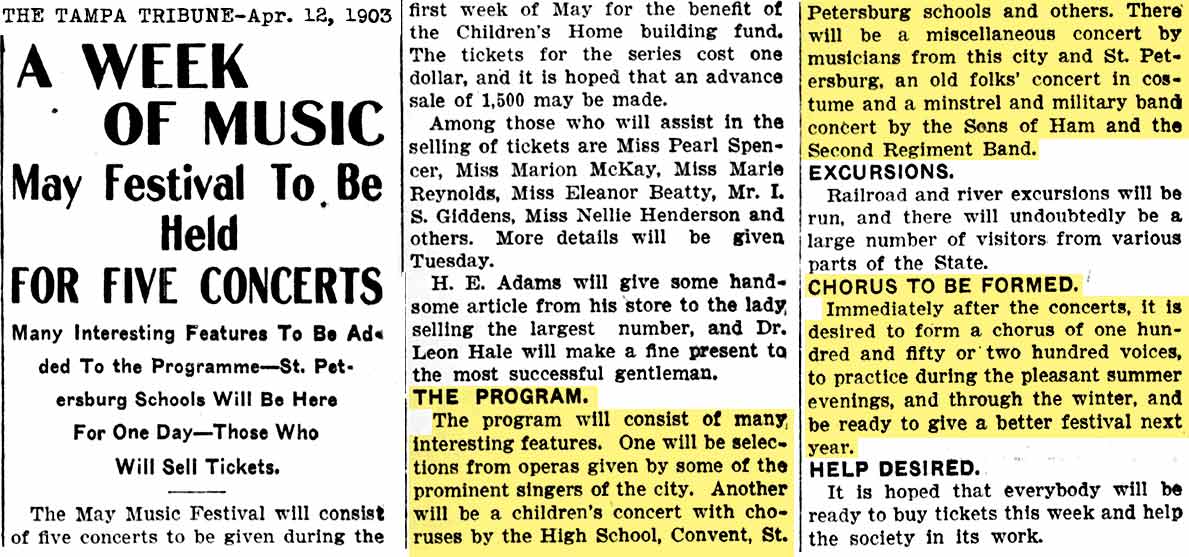
| |
|
April 26,
1903 - The Tribune published more details on the events
of the 1903 May Festival. Participation by citizens of St.
Petersburg is seen as an opportunity for "the people of
the two places to get better acquainted" and urges
Tampans to show friendship in every possible way.
Organizers of the musical events are named as well as
specific school groups and their activities.
|
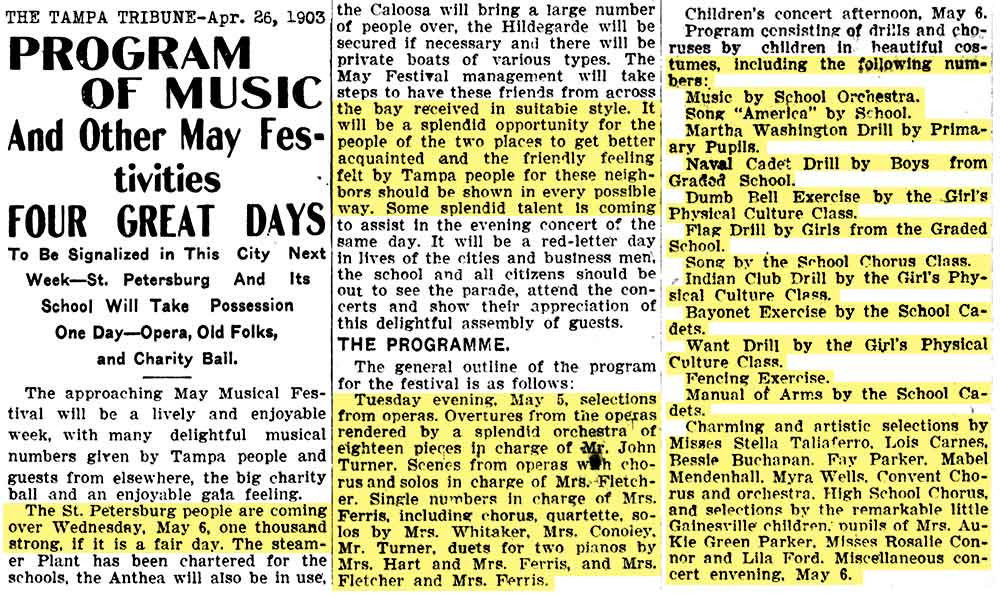
| |
|
THE TRIBUNE
PUBLISHES THE FESTIVAL EVENTS SCHEDULE IN DETAIL
This is a very long article, only the beginning is shown
here. "The Festival week is intended to include a
Floral Parade" but there is NO mention of a parade in
the details. Dodge often comments on programs not being
up to par due to lack of preparation time.
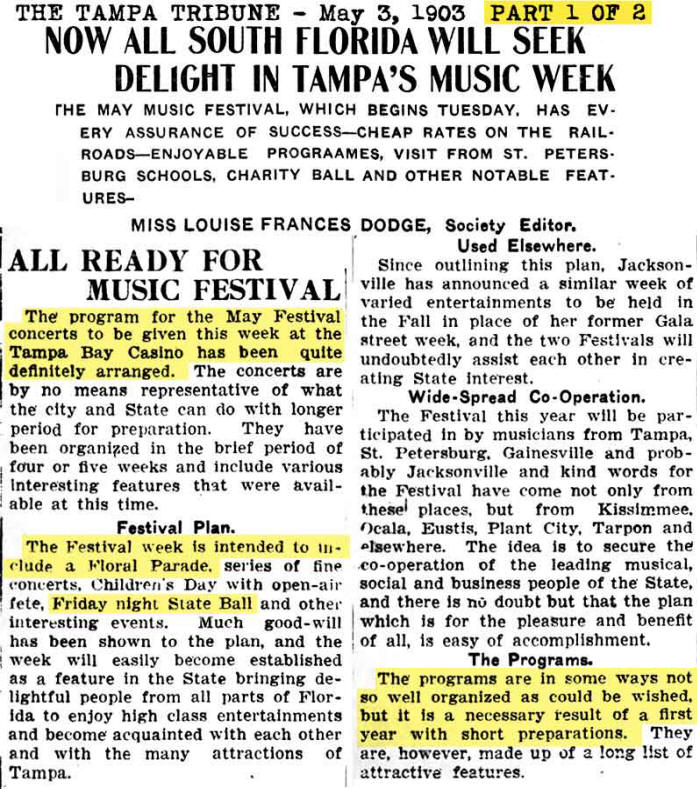 |
Click to see the details of every event
including songs and performers' names.
MAY 6,
1903 -
A REVIEW
OF FESTIVAL OPENING NIGHT ACTS
|
The Tampa
Bay Casino on the grounds of the Tampa Bay Hotel was the
venue for the opening night "high class operatic
concert." The proceeds of this event and the
others was to assist in building a suitable home for the
homeless children of Tampa.
|
|
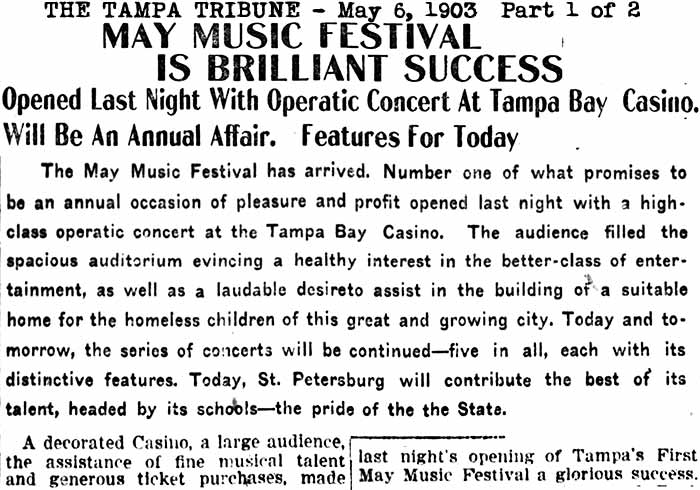
Click to see the conclusion of this article.
|
THE TAMPA BAY HOTEL CASINO
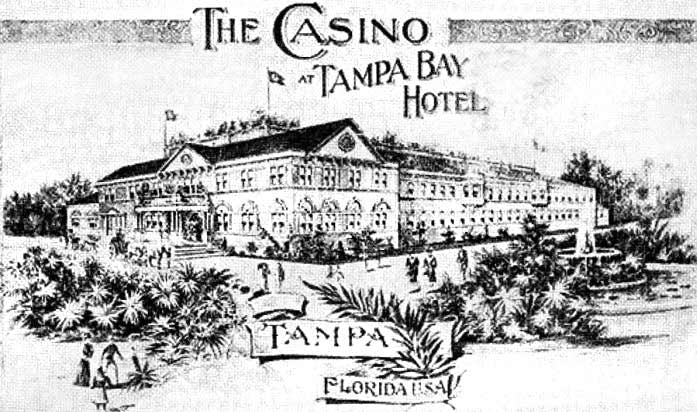
Image from
Karl Grismer's History of Tampa
published in 1950 and available at USF
Digital Commons.
The Tampa Bay Hotel Casino
was not a house of gambling (at least, not
that we know of.) It served Tampa
as an auditorium, performance hall,
recreation center, and as a center
for social events. It was the venue for most
all (if not all) the Gasparilla grand
coronation balls.
Early in April 1895,
Henry Plant announced that he intended to
build a fine casino at the Tampa Bay Hotel.
Work on the large two-story structure was
started soon after ward. The Casino
was T-shaped and had a 2000-seat auditorium,
heated swimming pool, bowling alley, spa
facilities and card rooms. It was a
122 by 58 foot clubhouse in front and a
combined auditorium the heated swimming
pool 157 by 88 feet, extending to the rear.
The swimming pool was under the removable
floor of the auditorium. The casino was
opened Tuesday night, Dec. 3, 1896, with the
play "The Right to Happiness," starring the
famous actress Minnie Maddern Fiske. Many
other first class attractions appeared later
in the casino.
In a letter from the traffic manager of the
Plant System, H.B. Plant sets the record
straight about the purpose of the Casino.
The press was describing it as "being built
for the accommodation and pleasure of the
guests of the Tampa Bay Hotel. He says
"the auditorium was built for the people of
Tampa and the guests will have no more
rights and privileges than the humblest
citizen of Tampa."
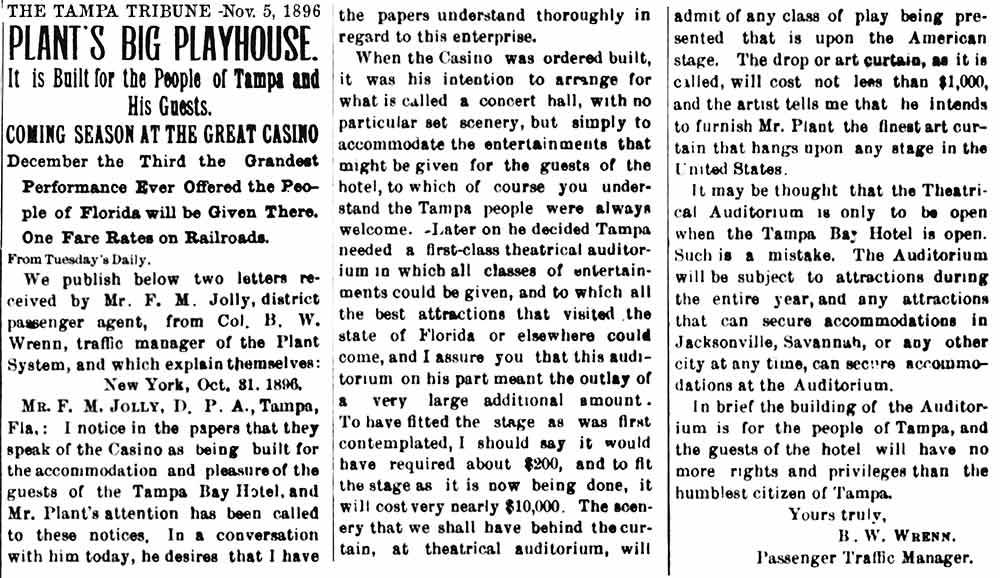
Most of this info is from Karl Grismer's History of Tampa
edited by D.B. McKay and published in 1950,
available at
USF Digital Commons.
Click to read the entire Dec. 4, 1896
article about the opening night
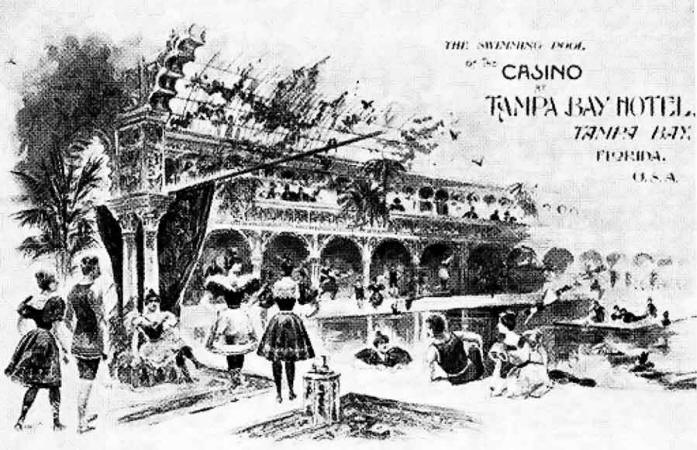
Illustration from Karl Grismer's History of Tampa
edited by D.B. McKay and published in 1950,
available at
USF Digital Commons.
|
|
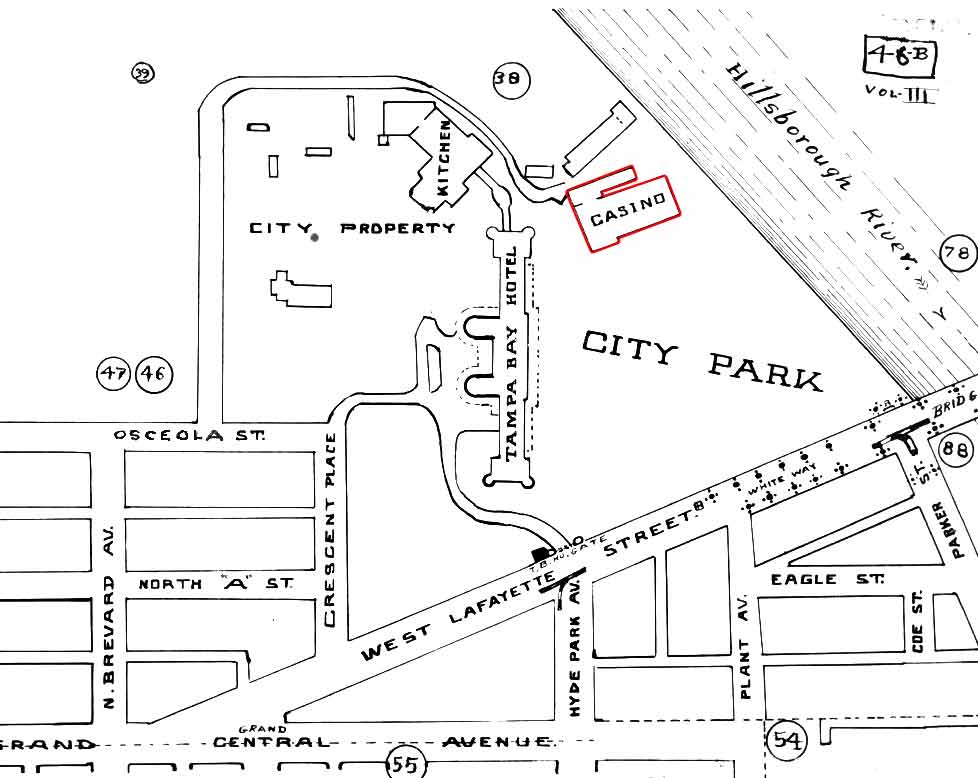
Above from 1927 plat book.
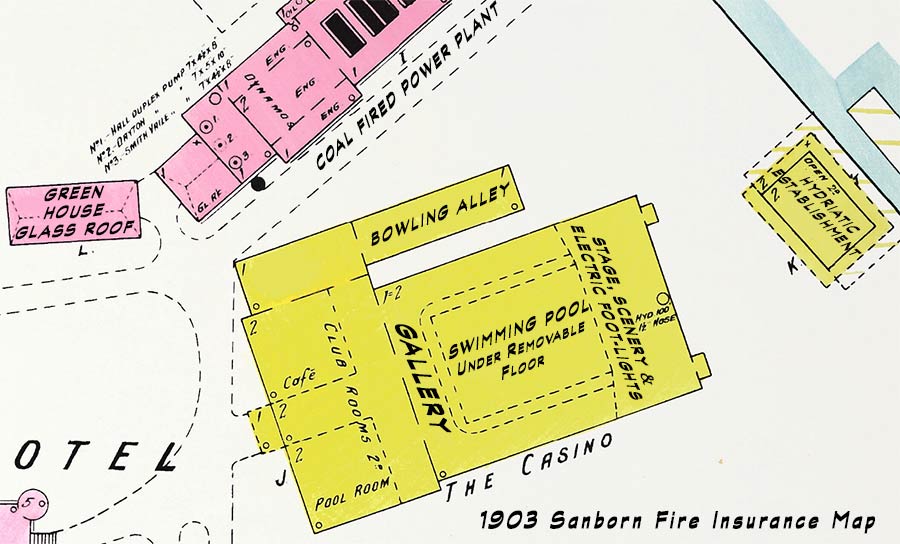
Sanborn Fire insurance map from
University of Florida Map
collection.
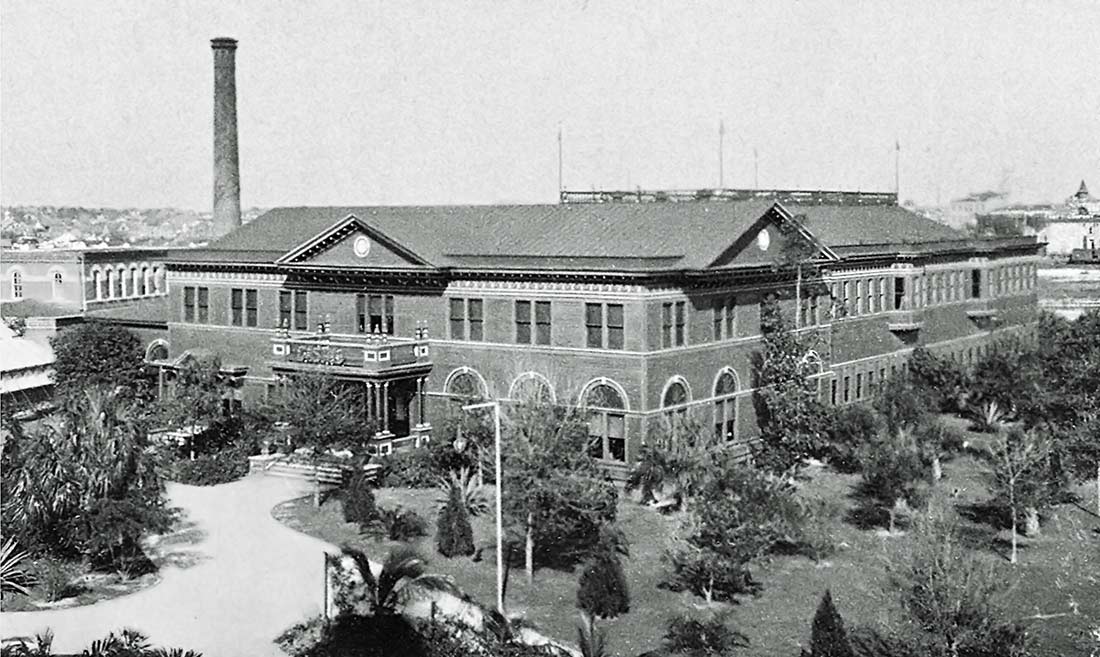
Undated photo from the H.B.
Plant Museum "Plant's Follies."
The power station and smokestack
can be seen at left.
A project favored by the
voters of Tampa in 1926 was the conversion
of the Tampa Bay Casino, owned by the city,
into a much-needed auditorium, $250,000
being voted for the purpose. But after
reconsidering, the city commissioners
decided that the casino would not have a
large enough seating capacity so an entirely
new structure was ordered built at the north
end of Crescent Place. It was completed in
the early fall of 1926 at a cost of $297,352
and was opened October 19 with the operetta
"The Lovely Galatea," played by the Thalians. Nat B. Rogers was named first
manager of the auditorium which initially
was called "Municipal Auditorium" and years
later renamed "McKay Auditorium after
former mayor D. B. McKay."
Most of this info is from Karl Grismer's History of Tampa
edited by D.B. McKay and published in 1950,
available at
USF Digital Commons.
By the
1930s it had been renamed as the American
Legion Casino and housed over 4,000 military
draft records.
It was destroyed by
fire on July 20, 1941.
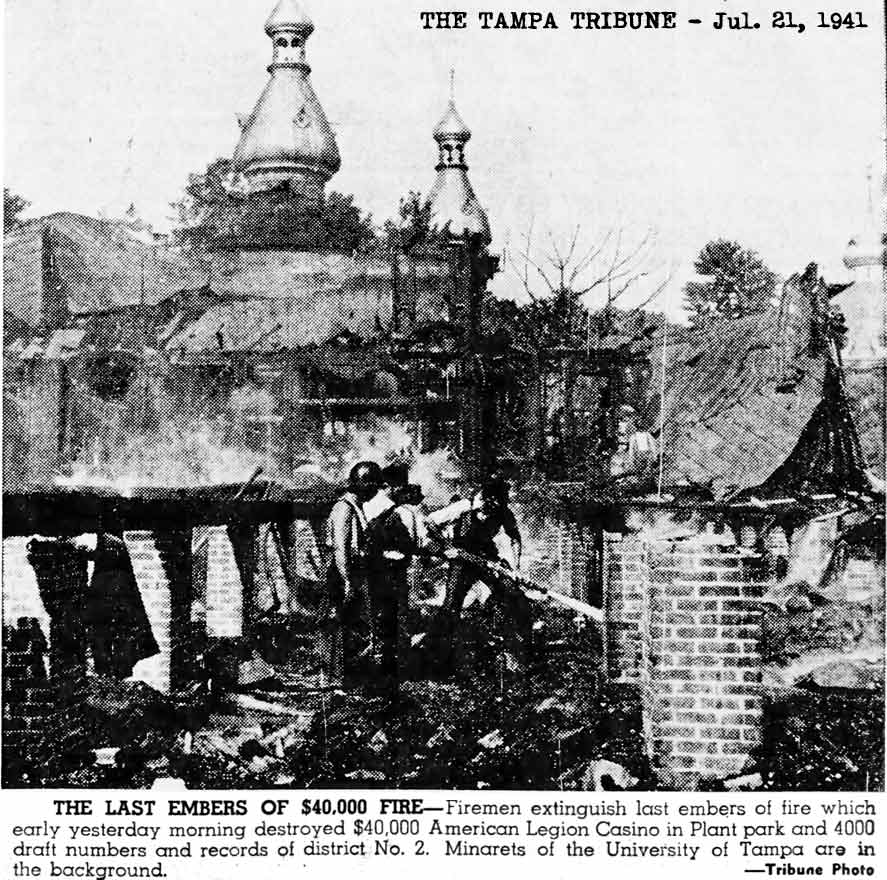 |
BRANCH'S OPERA HOUSE
Before the Tampa Bay Hotel
Casino was built, Branch's Opera
house on the 400 block of
Franklin St. in front of
courthouse square (between
Lafayette St. and Madison St.) served as
Tampa's performance and large
meeting hall. All the
structures on this block were
built in the first few months of
1884. |
|
|
Emery, Simmons & Emery Boots &
Shoes opened in March 1884 with
David S. Macfarlane, brother of
Hugh Macfarlane, as manager.
David was the first
of the Macfarlane
brothers to come to
Tampa. From
Jacksonville where
he worked for Emery
& Simmons, David and
his family came to
Tampa in March 1884
to take charge of
the newly opened
boot & shoe store
for Emery, Simmons &
Emery on the 400
block of Franklin
St, next to Branch's
opera house. His
original position in
Jacksonville was
replaced by his
brother, Matthew.
Matthew would have
been around 23 years
old at the time.
David was 26.
David quickly bought the
business from Emery & Simmons
and had great success for almost
16 years with partners coming
and leaving over the years.
Shortly after David
took the position
here with Emery et
al. he contacted his
brother Hugh in New
Orleans and
convinced him to
move to Tampa.
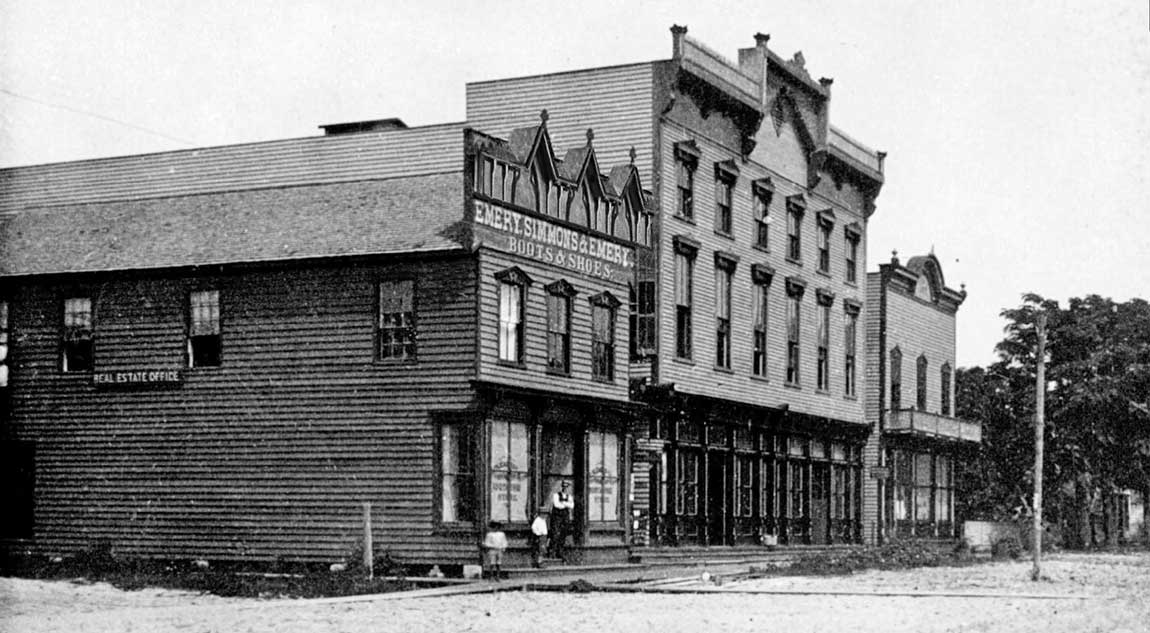
Photo by
James C. Field courtesy of University of Florida,
Florida Photo Collection
where they incorrectly claim the photo is circa 1870s.
The photo is from March 1884.
Tampa built its first opera house
during the winter of 1883-84.
It was formally opened Friday,
March 7, 1884 with Lambert &
Richardson's Dramatic Troupe
presenting the uproarious comedy
"Fate." "Our Boys" was given at
the Saturday matinee and
"Bachelors" Saturday night
(according to Karl Grismer in
his 1950 book "A History of
Tampa..etc.) There are no
newspapers available for the
period of its construction and
opening but they must have been
the source of Grismer's detailed
knowledge concerning the
opening. It's doubtful his
editor, D.B. McKay would have
remembered details as he was a
young boy in these years.)
For twelve or so years
thereafter, Branch's Opera
House was the only theatre
in Tampa. It also served as
a banquet hall and was used
for dances and many other
affairs such as the 1886
Hillsborough County High
School commencement ceremony.
Located at the southeast
comer of the block enclosed
by Franklin, Lafayette,
Tampa, and Madison streets,
the building was three
stories high but with just 2
floors, the 2nd floor
housing the opera house
stage and seating, and a
hardware store on the ground
floor. The owner was
Harry Lee Branch, a
young local attorney, the
only child of Dr. Franklin
Branch and his third wife
Martha A. Turnbull.
Among Harry's numerous older
half-brothers was Darwin
Austen Branch, former Tampa
mayor.
Music for many of the events
in the opera house was
furnished by the Tampa
Silver Cornet Band organized
in April, 1885 by A. A.
Kelso, a skilled musician,
band leader and business
manager.
It was the venue where
Tampa's Board of Trade was
formed on
Thursday night, May 7th,
1885 and held its historic,
first meeting for the
purpose of taking on on some
of the area's biggest
problems: heavy traffic,
lack of bridges and how to
attract new businesses. At
the meeting, the top men of
the city were on hand, and
twenty-seven of them were
enrolled as charter members
of the Tampa Board of Trade
that first meeting. These
highly respected men lead
Tampa to become a more
desirable place to live,
work and do business. As
president of the Tampa Board
of Trade, Dr. John P. Wall
supported an innovative
transportation system,
called the Plant System,
which allowed Tampa to
branch out to neighboring
and distant cities through
the construction and
improvement of bridges,
railroads, and waterworks.
A meeting of the Board of
Trade was called at the
opera house on October 5,
1885, “for the purpose of
working some arrangements in
order to retain the cigar
factories in Tampa.” William
B. Henderson presided. The
Board would soon help
Vicente Martinez Ybor and
partner Eduardo Manrara to
broker a land deal to move
their cigar manufacturing
operations to Tampa from Key
West. Decades later, the
Tampa Board of Trade became
the Tampa Chamber of
Commerce.
In 1885, the Hillsborough County School Board sold their school property on the 500 block
of Franklin St.
to Sparkman and Sparkman (which then became the Sparkman Block)
and
purchased an entire block on Jefferson Street, between Henderson
Street
and Estelle Street. (Ybor's 6th
Ave. was called Henderson St. north of downtown). Under the
guidance of Superintendant
William B. Henderson, a new
8-room schoolhouse was built
on this property at a cost
of $4,735 for the purpose of
teaching elementary and high
school classes.
In 1887, five female
students graduated from this
Hillsborough County High
School with a formal
ceremony at Branch's opera
house, Each student read her
graduating speech by the
light of oil lamps which
hung along the walls. The
school was located at their
second home, the southwest
corner of 6th Ave. and
Jefferson St.
Opera house sketch courtesy
of
Descriptive pamphlet of
Hillsborough county, Florida
by Hillsborough county real
estate agency, Tampa, Fla.
Publication date 1885 at
Internet Archive. |
|
|
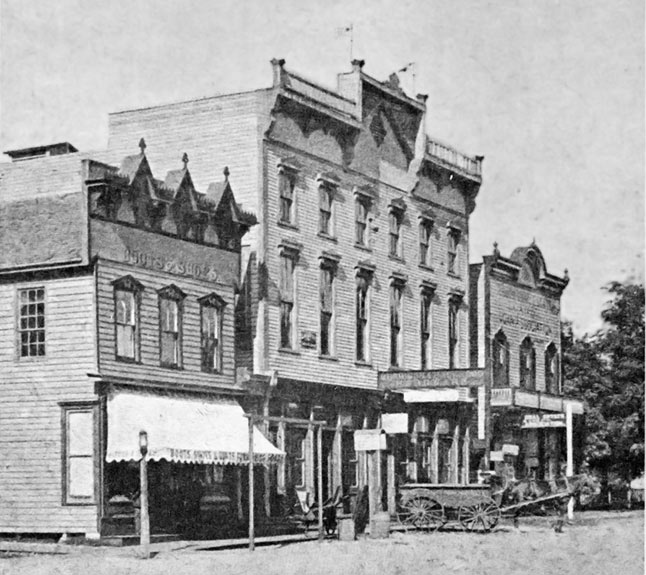
Photo
courtesy of "Tampa Town 1824 - 1886" by Tony Pizzo. |
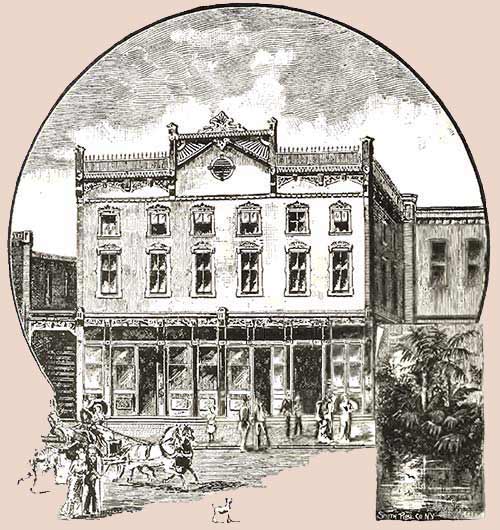 |
|
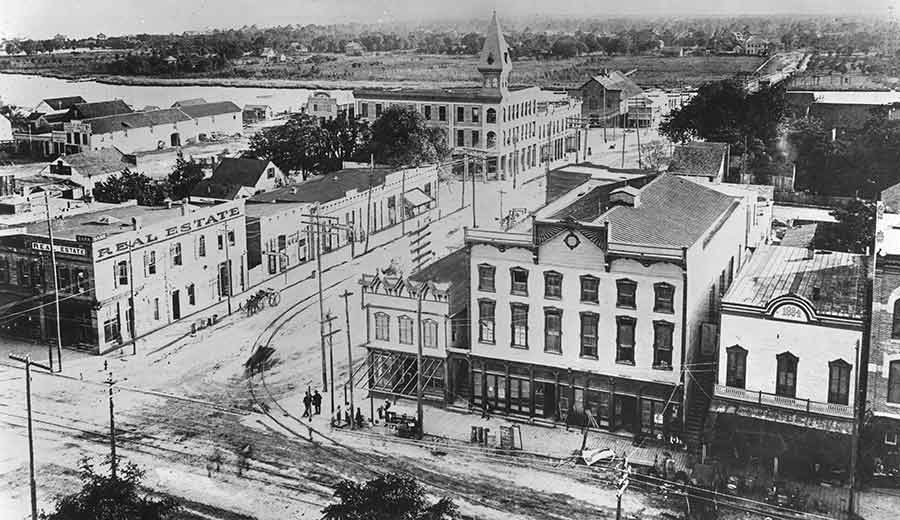
This photo taken and enhanced with
outlines by the Burgert Bros. Commercial
Photography Studio shows the intersection of
the 400 block of Franklin St. and Lafayette
St. Tibbets Corner can be seen at far
left, and the newly built Knight & Wall
Hardware building with the steeple at
Lafayette & Tampa St. Courtesy of the
USF Burgert Bros. collection where it is
incorrectly dated Jan. 1900.
As you will see, Branch's opera house
(renamed the Ball bros opera house) was
demolished in May 1893. Here, the opera
house and David Macfarlane's boot & shoe
store can be seen abandoned.
Macfarlane had moved his store one block
north on Franklin St. to the Sparkman block
on June 23, 1887.
|
|
Contrary
to what "Tampa, The Treasure City" says, the
Tampa Bay Casino did NOT put
Branch's Opera House out of
business.
In May 1893 the opera house was
being referred to in the
Tribune as "Ball's Opera
House" because it had been
purchased by the Ball
brothers. The building sat
unused until they had it demolished in May 1893 in order to
start building brick
structures on the block.
However, before building, they sold the vacant property
to A.J. Knight. Newspapers are also missing for
the months before this, so
details of the transfer from Harry Branch to the Ball
brothers are unknown.
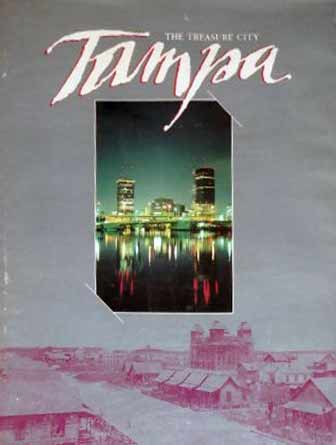 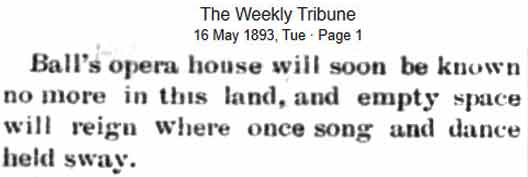
 |
|
|
KUDOS TO
LOUISE FRANCES DODGE
This article has been trimmed to show only the start
and the section about Miss Dodge.
Click to read the reviews of the previous day's events
and description of the upcoming scheduled events.
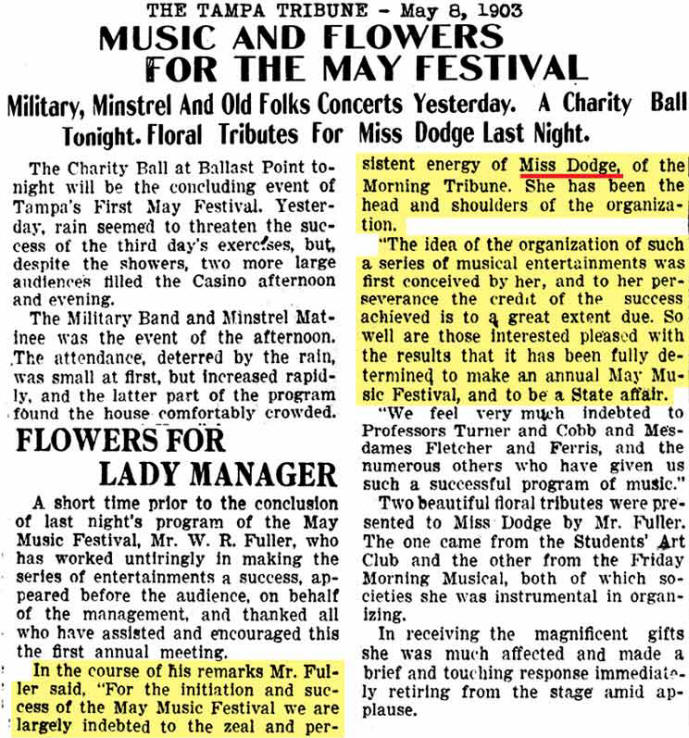
| |
|
THE
TRIBUNE'S REVIEW OF THE FESTIVAL'S CLOSING EVENT - A
CHARITY BALL
A charity
ball was held at the Ballast Point Pavilion as the final
event of the 1903 May Festival. The festival
"closed in a blaze of glory" thus ending the "successful
Festival." Mr. Turner's fifteen piece orchestra
provided the music and the dancing lasted from 9 p.m. to
1 a.m. Proceeds of the ball amounted to a "handsome sum"
which would be donated to the building fund of the
Chilldren's Home along with other profits of the
festival. Although the article states that Miss
Dodge would write a review of the Festival in Sunday's
paper, it was not published until Tuesday, May 12.
The Tribune did not publish on Mondays in those years.
|
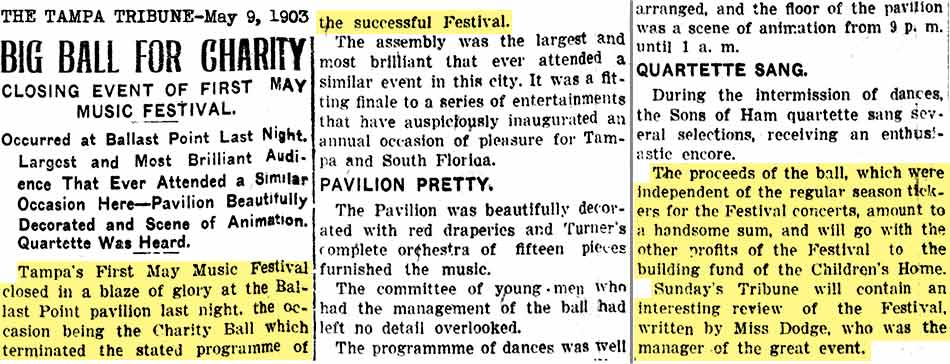
|
A REVIEW BY LOUISE DODGE
Louise
Dodge published her review of the 1903 May Festival in
the Tuesday, May 12, 1903 edition of the Tampa Tribune.
She discusses the topic of permanence of this type
of event each year and plans already in the works to
start various music groups year round. She often
mentions the shortness of preparation time for the
festival, implying that the events could have been
better: "...for the short period of preparation
given to them..." but makes reference to what one
gentleman remarked that the qualifying phrase was not
needed. |
|
This is the start of the article,
click to read the rest. Dodge
names lots of people who contributed to the
success of the festival. |

NEXT
PAGE: THE 1904 MAY FESTIVAL AND FIRST APPEARANCE OF
GASPARILLA'S YE MYSTIC KREWE
|
|